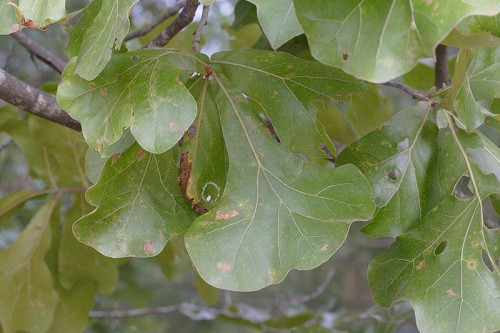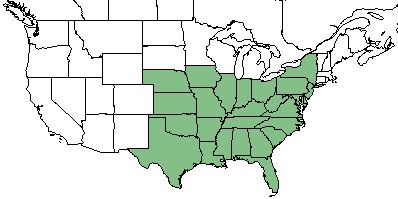Difference between revisions of "Quercus marilandica"
(→Habitat) |
(→Habitat) |
||
| Line 32: | Line 32: | ||
===Habitat=== | ===Habitat=== | ||
| + | ''Q. marilandica'' has been found in sandridges, sandpine woods, oak-pine woodlands, and pine flatwoods.<ref name="FSU"> Florida State University Herbarium Database. URL: http://herbarium.bio.fsu.edu. Last accessed: June 2021. Collectors: Loran C. Anderson, D. E. Frazier, Robert K. Godfrey, H. Kurz, and W. D. Reese. States and counties: Florida: Jackson, Leon, Liberty, and Okaloosa.</ref> It is also found in disturbed areas including gravel dumps, old fields, and burned dry oak-hickory woodlands.<ref name="FSU"/> Associated species: ''Q. arkansana, Q. geminata, Q. laevis, Q. hemisphaerica, Q. myrtifolia'', and ''Q. stellata''.<ref name="FSU"/> Common habitats include upland forests and woodlands. It prefers droughty soils of clay, deep sands, or sandstones.<ref name= "Weakley"> Weakley, A. S. (2015). Flora of the Southern and Mid-Atlantic States. Chapel Hill, NC, University of North Carolina Herbarium.</ref> | ||
| − | ''Q. marilandica'' has been | + | ''Q. marilandica'' has been known to have a high tolerance to drought but it is not tolerant of shade.<ref name= "USDA"> [https://plants.usda.gov/core/profile?symbol=CEAM USDA Plant Database]</ref> ''Q. marilandica'' was unaffected by agricultural-based soil disturbance in South Carolina coastal plains communities.<ref>Brudvig, L.A., J.L. Orrock, E.I. Damschen, C.D. Collins, P.G. Hahn, W.B. Mattingly, J.W. Veldman, and J.L. Walker. (2014). Land-Use History and Contemporary Management Inform an Ecological Reference Model for Longleaf Pine Woodland Understory Plant Communities. PLoS ONE 9(1): e86604.</ref> |
| − | ''Q. marilandica'' | + | ''Q. marilandica'' became absent in response to military training in west Georgia longleaf pine forests. It has shown resistance to regrowth in reestablished longleaf habitats that were disturbed by this activity.<ref>Dale, V.H., S.C. Beyeler, and B. Jackson. (2002). Understory vegetation indicators of anthropogenic disturbance in longleaf pine forests at Fort Benning, Georgia, USA. Ecological Indicators 1(3):155-170.</ref> |
<!--Natural communities, human disturbed habitats, topography, hydrology, soils, light, fire regime requirements for removal of competition, etc.--> | <!--Natural communities, human disturbed habitats, topography, hydrology, soils, light, fire regime requirements for removal of competition, etc.--> | ||
Revision as of 19:04, 23 June 2021
| Quercus marilandica | |
|---|---|

| |
| Photo by John Gwaltney hosted at Southeastern Flora.com | |
| Scientific classification | |
| Kingdom: | Plantae |
| Division: | Magnoliophyta - Flowering plants |
| Class: | Magnoliopsida - Dicots |
| Order: | Fagales |
| Family: | Fagaceae |
| Genus: | Quercus |
| Species: | Q. marilandica |
| Binomial name | |
| Quercus marilandica Munchh | |

| |
| Natural range of Quercus marilandica from USDA NRCS Plants Database. | |
Contents
Taxonomic Notes
Synonym: Quercus neoshei (Bush)
Variety: Quercus marilandica Muenchhausen var. ashei Sudw.; Quercus marilandica Muenchhausen var. marilandica
Description
Q. marilandica is a perennial shrub/tree of the Fagaceae family that is native to North America.[1]
Distribution
Q. marilandica is found throughout the eastern United States; as far north as New York and as far west as Texas.[1]
Ecology
Habitat
Q. marilandica has been found in sandridges, sandpine woods, oak-pine woodlands, and pine flatwoods.[2] It is also found in disturbed areas including gravel dumps, old fields, and burned dry oak-hickory woodlands.[2] Associated species: Q. arkansana, Q. geminata, Q. laevis, Q. hemisphaerica, Q. myrtifolia, and Q. stellata.[2] Common habitats include upland forests and woodlands. It prefers droughty soils of clay, deep sands, or sandstones.[3]
Q. marilandica has been known to have a high tolerance to drought but it is not tolerant of shade.[1] Q. marilandica was unaffected by agricultural-based soil disturbance in South Carolina coastal plains communities.[4]
Q. marilandica became absent in response to military training in west Georgia longleaf pine forests. It has shown resistance to regrowth in reestablished longleaf habitats that were disturbed by this activity.[5]
Phenology
Blooms typically occur during the mid spring and seeding in the fall.[1]
Fire ecology
Q. marilandica has a low tolerance for fire.[1]
Pollination and use by animals
Q. marilandica has been observed to host planthoppers such as Catonia sp. (family Achilidae), leafhoppers from the Cicadellidae family such as Alebra sp., Erasmoneura vulnerata, Eratoneura acantha, E. ardens and E. parva, and Cedusa sp. (family Derbidae) and members of the Flatidae family such as Metcalfa pruinosa and Flatormenis proxima, as well as treehoppers from the Membracidae family such as Cyrtolobus fuliginosus, Cyrtolobus ovatus, Cyrtolobus tuberosus, Entylia carinata, Ophiderma pubescens and Smilia camelus.[6]
Conservation, cultivation, and restoration
Cultural use
Photo Gallery
References and notes
- ↑ 1.0 1.1 1.2 1.3 1.4 USDA Plant Database
- ↑ 2.0 2.1 2.2 Florida State University Herbarium Database. URL: http://herbarium.bio.fsu.edu. Last accessed: June 2021. Collectors: Loran C. Anderson, D. E. Frazier, Robert K. Godfrey, H. Kurz, and W. D. Reese. States and counties: Florida: Jackson, Leon, Liberty, and Okaloosa.
- ↑ Weakley, A. S. (2015). Flora of the Southern and Mid-Atlantic States. Chapel Hill, NC, University of North Carolina Herbarium.
- ↑ Brudvig, L.A., J.L. Orrock, E.I. Damschen, C.D. Collins, P.G. Hahn, W.B. Mattingly, J.W. Veldman, and J.L. Walker. (2014). Land-Use History and Contemporary Management Inform an Ecological Reference Model for Longleaf Pine Woodland Understory Plant Communities. PLoS ONE 9(1): e86604.
- ↑ Dale, V.H., S.C. Beyeler, and B. Jackson. (2002). Understory vegetation indicators of anthropogenic disturbance in longleaf pine forests at Fort Benning, Georgia, USA. Ecological Indicators 1(3):155-170.
- ↑ Discoverlife.org [1]